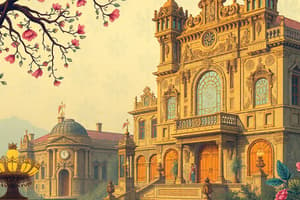Podcast
Questions and Answers
What is NOT considered a political factor in PESTEL analysis?
What is NOT considered a political factor in PESTEL analysis?
- Government intervention
- Tariffs
- Cultural trends (correct)
- Tax policy
Which of the following factors would be found under the 'E' category in the PESTEL analysis?
Which of the following factors would be found under the 'E' category in the PESTEL analysis?
- Environmental sustainability (correct)
- Demographic shifts
- Government regulations
- Economic growth rates
Which element is part of a firm's external environment according to the PESTEL framework?
Which element is part of a firm's external environment according to the PESTEL framework?
- Management structure
- Political climate (correct)
- Internal policies
- Corporate culture
What type of analysis is PESTEL primarily used for?
What type of analysis is PESTEL primarily used for?
Which factor is NOT typically included in the PESTEL analysis?
Which factor is NOT typically included in the PESTEL analysis?
Which of the following would be considered a direct impact of government intervention in a business's PESTEL analysis?
Which of the following would be considered a direct impact of government intervention in a business's PESTEL analysis?
What does the 'S' in PESTEL stand for?
What does the 'S' in PESTEL stand for?
Which of the following is not considered an economic factor in PESTEL analysis?
Which of the following is not considered an economic factor in PESTEL analysis?
In PESTEL analysis, which factor would most likely influence consumer purchasing power?
In PESTEL analysis, which factor would most likely influence consumer purchasing power?
What economic factor is assessed through the analysis of exchange rates?
What economic factor is assessed through the analysis of exchange rates?
Which of the following PESTEL factors is primarily concerned with societal trends and conditions?
Which of the following PESTEL factors is primarily concerned with societal trends and conditions?
Which of the following elements would be classified under sociocultural factors in a PESTEL analysis?
Which of the following elements would be classified under sociocultural factors in a PESTEL analysis?
Which economic factor reflects the total value of goods and services produced per person?
Which economic factor reflects the total value of goods and services produced per person?
Identify the economic factor that directly affects the cost of borrowing money.
Identify the economic factor that directly affects the cost of borrowing money.
Which of the following options does not belong to the list of economic factors in PESTEL?
Which of the following options does not belong to the list of economic factors in PESTEL?
Which of the following describes a sociocultural factor affecting markets in advanced economies?
Which of the following describes a sociocultural factor affecting markets in advanced economies?
What is an example of a technological factor that can influence strategic decisions?
What is an example of a technological factor that can influence strategic decisions?
Which of the following is NOT a sociocultural factor in the PESTEL analysis?
Which of the following is NOT a sociocultural factor in the PESTEL analysis?
Environmental factors include challenges like:
Environmental factors include challenges like:
What is a demographic trend affecting advanced economies?
What is a demographic trend affecting advanced economies?
Which of the following best defines the impact of climate change as an environmental factor?
Which of the following best defines the impact of climate change as an environmental factor?
Which of the following statements is true regarding technological factors in PESTEL?
Which of the following statements is true regarding technological factors in PESTEL?
What is a cultural aspect identified in the PESTEL analysis?
What is a cultural aspect identified in the PESTEL analysis?
Flashcards
Economic Factors
Economic Factors
Factors related to a country's economy such as economic growth, unemployment, inflation, interest rates, exchange rates, trade deficits/surpluses, and GDP per capita. These factors can significantly influence a company's operations and profitability.
Economic Growth
Economic Growth
The overall increase in the production of goods and services in a country. Positive economic growth indicates a healthy economy.
Unemployment
Unemployment
The percentage of the workforce who are unemployed and actively seeking work. High unemployment indicates a struggling economy.
Inflation
Inflation
Signup and view all the flashcards
Interest Rates
Interest Rates
Signup and view all the flashcards
Exchange Rates
Exchange Rates
Signup and view all the flashcards
Trade Deficits/Surpluses
Trade Deficits/Surpluses
Signup and view all the flashcards
GDP Per Capita
GDP Per Capita
Signup and view all the flashcards
Crafting and executing strategy
Crafting and executing strategy
Signup and view all the flashcards
Levels of the Firm’s Environment
Levels of the Firm’s Environment
Signup and view all the flashcards
Competitive Environment
Competitive Environment
Signup and view all the flashcards
General Environment
General Environment
Signup and view all the flashcards
PESTEL Analysis
PESTEL Analysis
Signup and view all the flashcards
PESTEL - Political Factors
PESTEL - Political Factors
Signup and view all the flashcards
PESTEL - Economic Factors
PESTEL - Economic Factors
Signup and view all the flashcards
PESTEL - Social Factors
PESTEL - Social Factors
Signup and view all the flashcards
Demographics
Demographics
Signup and view all the flashcards
Concentration in mega-cities
Concentration in mega-cities
Signup and view all the flashcards
Distribution
Distribution
Signup and view all the flashcards
Technological change
Technological change
Signup and view all the flashcards
Disruptive technologies
Disruptive technologies
Signup and view all the flashcards
Environmental factors
Environmental factors
Signup and view all the flashcards
Culture
Culture
Signup and view all the flashcards
Climate change
Climate change
Signup and view all the flashcards
Study Notes
Strategic Thinking in a Complex World - Session 3
- Strategic Thinking Framework (5 Stages):
- Stage 1: Develop a strategic vision, mission, and core values.
- Stage 2: Set objectives.
- Stage 3: Craft a strategy to achieve objectives and company vision.
- Stage 4: Execute the strategy.
- Stage 5: Monitor developments, evaluate performance, and make adjustments.
- Key takeaway: Continuous revision is essential, adapting to changing company performance, conditions, new opportunities, and ideas.
Firm's Environment Levels
-
Macro-Environment:
- Political: Political climate, government intervention, tax policy, tariffs, and more.
- Economic: Economic growth, unemployment, inflation, interest rates, exchange rates, trade surpluses/deficits, and GDP per capita.
- Sociocultural: Values, culture, demographics, inequality, lifestyles, etc.
- Technological: Technological change, disruptive technologies, institutions (e.g., patent system).
- Environmental: Climate change, water and food shortages.
- Legal/Regulatory: Labor, consumer, antitrust laws, regulations, and court efficiency.
-
Immediate Industry & Competitive Environment:
- Suppliers
- Substitute products
- Rival firms
- New entrants
- Buyers
PESTEL Analysis
- Political Factors: Political climate, government intervention, tax/fiscal/energy policy, tariffs, etc.
- Economic Factors: Economic growth, unemployment, inflation, interest rates, exchange rates, trade deficits/surpluses, GDP per capita, etc.
- Sociocultural Factors: Values, culture, demographics, inequality, lifestyles, etc.
- Technological Factors: Technological change, disruptive technologies, institutions (e.g., patent system), etc.
- Environmental Factors: Climate change, shortages of water/food, etc.
- Legal/Regulatory Factors: Labor, consumer, antitrust laws/regulations, efficiency of courts and institutions, etc.
Studying That Suits You
Use AI to generate personalized quizzes and flashcards to suit your learning preferences.



